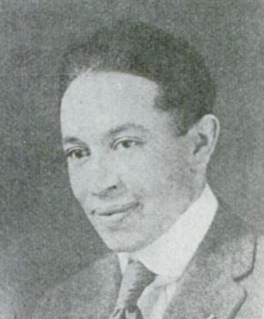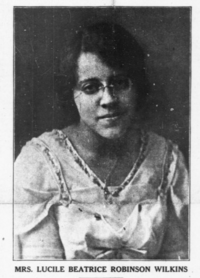J. Ernest Wilkins Sr. facts for kids
Quick facts for kids
J. Ernest Wilkins Sr.
|
|
|---|---|

J. Ernest Wilkins Sr.
U.S. Assistant Secretary of Labor, 1954–58 |
|
| Born | February 1, 1894 |
| Died | January 19, 1959 (aged 64) |
| Resting place | Lincoln Cemetery |
| Alma mater | University of Illinois; University of Chicago |
| Known for | Labor leader, Undersecretary of Labor, Civil Rights |
| Political party | Republican |
| Spouse(s) |
Lucille Robinson
(m. 1922) |
| Children | 3 sons, including J. Ernest Wilkins Jr. |
Jesse Ernest Wilkins Sr. (born February 1, 1894 – died January 19, 1959) was an important American leader. He was a lawyer and a labor leader. He also served as an undersecretary in the government under President Dwight D. Eisenhower.
Wilkins made history as the first African-American person to hold a high-level position in the U.S. government. He was also the first African-American to attend important meetings with the President's Cabinet at the White House.
After some disagreements with the Secretary of Labor, James P. Mitchell, Wilkins left his government job in 1958. However, he continued his important work on the U.S. Civil Rights Commission.
Contents
Early Life and Education
Jesse Ernest Wilkins Sr. grew up in Missouri. His father was a Baptist preacher. Jesse was a very bright student.
He studied mathematics at the University of Illinois. Later, he went to the University of Chicago Law School in the 1920s. He was a top student and became a member of the Phi Beta Kappa Society. After finishing law school, he worked as a lawyer for many years.
Public Service and Civil Rights Work
In 1954, President Dwight D. Eisenhower chose Wilkins for a special job. He became the Undersecretary of Labor for International Labor Affairs. This made him the first African-American to attend important Cabinet-level meetings at the White House. He would attend these meetings when his boss, the Labor Secretary, was not there.
Before this, Wilkins also helped President Eisenhower with other important tasks. He worked on committees that made sure government contracts were fair. He also worked on a committee focused on fair employment policies in the government.
Working for Equality
Wilkins was part of a group called the Equality Committee. This group worked to make things fair for everyone. He worked alongside other important figures like E. Frederic Morrow and Val Washington.
In 1957, Wilkins was appointed to the U.S. Civil Rights Commission. He was the first Black member of this important commission. This group worked to protect the rights of all Americans, especially voting rights.
Challenges and Resignation
Wilkins faced challenges in his role. The Labor Secretary, James Mitchell, tried to remove him from his position. Mitchell even tried to stop Wilkins from attending an important international meeting.
After these difficulties, Wilkins had a heart attack. He was in the hospital for three months. When he returned to work, things were still difficult.
In August 1958, Wilkins met with President Eisenhower. He asked to keep his job for a few more months. This would allow him to qualify for a government pension. However, President Eisenhower said that Secretary Mitchell had the right to choose his own team. Wilkins resigned from his sub-cabinet job in November 1958.
Continuing Civil Rights Work
Even after leaving his government job, Wilkins continued to serve on the Civil Rights Commission. He worked on the commission until he passed away two months later.
While working on the commission, Wilkins faced discrimination. In Montgomery, Alabama, he was not allowed to stay at the same hotel as the other commission members. He had to find a room at Maxwell Air Force Base.
The commission also faced problems when trying to investigate voting rights. A judge named George Wallace seized voting records. He threatened to jail any commission member who tried to get them. Wilkins and the commission continued their important work despite these obstacles.
Other Important Contributions
Wilkins had many other achievements. In 1953, he became the first African-American to serve on the Judicial Council of the Methodist Church. This council is an important leadership body for the church. He was even elected its secretary.
From 1954 to 1957, Wilkins represented the U.S. on the governing body of the International Labour Organization. This organization works to improve labor conditions around the world. In 1959, he also became the first African-American president of the Judicial Council of the Methodist Church.
He also served as the national president of the Kappa Alpha Psi Fraternity, Inc.
Family Life
Wilkins married Lucille Robinson in 1922. Lucille was a school teacher in Chicago. She also worked as a secretary for the women's division of the Methodist Church. She even practiced law with her husband for 33 years.
Jesse and Lucille had three sons. Their son, J. Ernest Wilkins Jr., became a famous mathematician and nuclear scientist. Another son, John Robinson Wilkins, was very smart. He went to the University of Wisconsin at age 14 and Harvard Law School at 19. He later worked for President Kennedy. Their third son, Julian B. Wilkins, became a lawyer too.
Jesse Ernest Wilkins Sr. passed away in Washington, D.C., in January 1959. He was 64 years old.
See also



